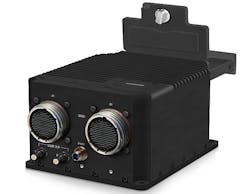General Micro Systems eyes Army WIN-T Increment 2 system for new Xeon-D based rugged computer
RANCHO CUCAMONGA, Calif., 5 Aug. 2016. U.S. Army land warfare experts needed a rugged computer for the second increment of the Warfighter Information Network-Tactical (WIN-T) Increment 2 to provide military vehicles with on-the-move communications, mission command, and situational awareness. They found their solution from General Micro Systems (GMS) in Rancho Cucamonga, Calif.
Officials of the Army Program Executive Office Command Control Communications-Tactical and General Dynamics Mission Systems in Scottsdale, Ariz., are using the GMS S902R Golden-Eye III rugged computer system in vehicle-mount WIN-T Increment 2 equipment, says GMS CEO Ben Sharfi.
The GMS S902R Golden-Eye III rugged computer is based on the Intel Xeon server-class microprocessor, and uses special proprietary ruggedization and cooling technologies that GMS officials call RuggedCool to enable the WIN-T equipment to operate in harsh battlefield conditions.
The GMS S902R rugged computers are part of a limited production run of WIN-T Increment 2 equipment that consists of rugged Cisco switches and routers, as well as the GMS rugged computers, Sharfi says.
GMS involvement in WIN-T Increment 2 may not stop there, however. GMS has introduced a new rugged computer based on the Intel Xeon D processor called the SB2002-SW Blackhawk computer system with switch and router.
GMS will compete the SB2002-SW for full-production runs of WIN-T Increment 2 later this fall, Sharfi says. "For the last year-plus we have been working on a new structure that we want to make smaller and cheaper," Sharfi says. "Our objective was to come up with the lowest-cost system with a reduced number of components."
For WIN-T GMS previously had offered the company's SZC91X Zeus rugged six-way secure virtual machine server, yet experts form the Army and General Dynamics concluded that approach was too large, heavy, and costly, Sharfi explains.
The Intel Xeon D processor provides the key to reducing the size, weight, and cost for WIN-T rugged computing, Sharfi says. The Xeon D is based on the Intel Core i7 microprocessor, but eliminates the chip's on-board graphics processing and adds processing cores. "It's ideal for virtual machines," Sharfi says.
Related: Beating the heat in high-performance embedded computing
The GMS SB2002-SW Blackhawk computer essentially enables data-center server processing performance for the battlefield without the rack, GMS officials say. It has as many as 16 processor cores, 20 managed Ethernet ports, 64 gigabytes of RAM, removable storage, Cisco embedded services router software, and high-level security in one seven-pound box that consumes as little as 75 Watts of power.
"We took the Cisco switch, the Cisco router, all the processing cores, and rolled it into one box," Sharfi says. "We can consolidate the storage, processor horsepower, embedded switch, and embedded router in one box that is about the same size as one S902R."
Not only is the box smaller and more power-efficient, but the GMS SB2002-SW Blackhawk computer also represents costs that can approach 10 times less than the SZC91X Zeus, S902R Golden-Eye III, and similar vehicle-mount rugged computing technologies, Sharfi says.
Related: The future of high-performance embedded computing
"I give credit to Intel for creating a 16-core Xeon D with 64 gigabytes of memory, and I give number-two credit to Cisco," Sharfi says.
Other potential applications for the SB2002-SW Blackhawk computer -- in addition to WIN-T -- include persistent surveillance, industrial automation, telemetry, Internet of Things (IoT) gateways, and rail transportation applications, Sharfi says.
For more information contact General Micro Systems online at www.gms4sbc.com.
Learn more: search the Aerospace & Defense Buyer's Guide for companies, new products, press releases, and videos

